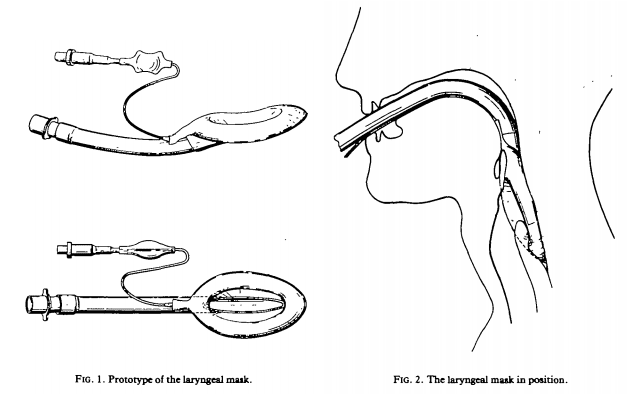Archie Brain
Archie Ian Jeremy Brain (1942 – ) is a British anaesthetist.
Brain is an award winning anaesthetist and is an honorary fellow of the Royal Collage of Anaesthetists. Brain is best known for inventing the Laryngeal Mask Airway (LMATM).
His medical education took place at the Radcliffe Infirmary in Oxford and he completed his clinical studies in St Bartholomew’s Hospital. He obtained a diploma in anesthetics within one year whilst working in Hastings, East Sussex.
From his time working as an anaesthetist he had the idea to attempt to make airway management less traumatic and more physiological. Whilst lecturing at The Royal London Hospital in 1980 he found the time to develop his ideas and the LMA was produced. Brain personally made his LMA prototypes and they were successfully trialled on patients from 1981. The first commercially made silicone model was released in 1988 and within 1 year it was used in more than 500 British hospitals and the LMA continues to be used today.
Biography
- Born on July 2, 1942 in Kobe, Japan. Son of Sir Norman and Lady Brain, British diplomats interned at the outbreak of World War Two. Later that year they were released and returned to the UK by ship.
- 1959 – Worcester College, Oxford to read modern languages and literature.
- 1963 – Stayed on at Oxford University to study basic sciences.
- 1970 – Completed clinical studies at St Bartholomew’s Hospital.
- 1971 – Anaesthetics training at Royal East Sussex Hospital.
- 1973 – Sole anaesthetist at Heemstede General Hospital, The Netherlands.
- 1980 – Worked as a lecturer at the now Royal London Hospital. Developed idea for LMA.
- 1981 – Prototype LMA first used on patient in William Harvey Hospital in Ashford, UK.
- 1982 – First study of LMA in 23 patients at Royal London Hospital. The laryngeal mask, LMA Classic™ was his 13th patent application, granted in 1982.
- 1983 – First published study involving the LMA – a case series of women undergoing gynaecological laparoscopy in the British Journal of Anaesthetics.
- 1988 – Brain demonstrates first commercially made silicone model. First commercial devices made available in the UK
- 1991 – Honorary consultant at Royal Berkshire Hospital in Reading, UK.
- 1993 – Brain’s Flexible LMA with armoured tube for head and neck surgery was released.
- 1995 – Awarded the Magill Gold Medal, the highest award of The Association of Anaesthetists of Great Britain and Ireland.
- 1997 – Brain introduces the intubating LMA.
- 1984-1990 Consultant Anaesthetist at Newham General Hospital, London.
- 1999 – The LMA pro seal released.
- 2000 – Elected Honorary fellow of the Royal Collage of Anaesthetists; Proseal LMA released with first use in Australia with Joe Brimacombe
- 2011 – Macewen Medal from the Difficult Airway Society for contribution to airway management.
Medical Eponyms
Laryngeal mask airway (1983)
The laryngeal mask was a new type of airway that could be used as an alternative to the endotracheal tube or the face mask with either spontaneous or positive pressure ventilation.
The Laryngeal mask airway is a surpraglottic airway device that is composed of an airway tube and an elliptical mask with a cuff that connects to the glottis. The cuff could be inflated to create a seal once in place and deflated for easy removal.
Viewed mechanically, tracheal intubation is a procedure in which two tubes, one man-made and the other anatomical, are connected together by inserting one into the other, a cuff being inflated on the inner tube to effect a gas-tight seal. In engineering terms, this solution to the problem of forming a gas-tight junction between two tubes is rather unsatisfactory, since it necessarily involves a degree of constriction at the point of junction unless the outer tube is itself expanded to compensate. Ideally, it is desirable that both tubes are of the same internal diameter at their point of junction, since this has clear advantages in terms of gas flow. This involves connecting them end to end, since the option of expanding the anatomical tube is not practicable.
An examination of postmortem specimens of the adult male and female larynx was made to assess how such a joint might be achieved. It was noted that an airtight seal could be effected against the perimeter of the larynx posteriorly by an elliptical cuff inflated in the hypopharynx. This observation led to the concept of the Laryngeal Mask.
Brain AIJ. Laryngeal mask BJA 1983

1986 – Brain developed the first wholly independent trial and chose John Nunn to be the recipient of the silicone prototypes to conduct the trial. A prototype size 3 laryngeal mask was used in 100 patients by 18 anaesthetists with no previous experience of its use.
There were three outstanding advantages of the LMA in patients who breathed spontaneously. Firstly, excellent airway patency was obtained in 98% of patients and did not deteriorate during the course of the anaesthetic. Secondly, as no manual support of the jaw was necessary the hands of the anaesthetist were freed for monitoring, record keeping and other tasks. Thirdly, it was possible to maintain a clear airway throughout transfer of the patient to the recovery room.
Brodrick PM, Webster NR, Nunn JF. Anaesthesia. 1989
The publication of this trial in 1989 was critical in kickstarting the uptake of the laryngeal mask in the UK
The invention of the LMA was a key contribution to anaesthetics. Prior to Brain’s invention the routine use of a facemask to manage the airway was not a hands-free technique, despite the development of various harnesses. This made adequate record-keeping difficult during anesthesia and made this mask a revolutionary change in anaesthetics. The masks are still used today in hospital and pre-hospital settings.
Dr Brain discusses how he became interested in anaesthesia, the invention of the LMA, the rejection of his invention and its ultimate success.
Major Publications
- Brain AI. The rapid induction technique for Caesarean section. Anaesthesia 1982; 37: 345
- Brain AI. The laryngeal mask–a new concept in airway management. Br J Anaesth. 1983; 55(8): 801-5. [Laryngeal mask airway]
- Brain AI. The laryngeal mask airway–a possible new solution to airway problems in the emergency situation. Arch Emerg Med. 1984; 1(4): 229-32.
- Brain AI. Risk of aspiration with the laryngeal mask. Br J Anaesth. 1994; 73(2): 278-9.
- Brain AI et al. The laryngeal mask airway. Development and preliminary trials of a new type of airway. Anaesthesia. 1985; 40(4): 356-61.
- Brain AI. Further developments of the laryngeal mask. Anaesthesia. 1989; 44(6): 530.
- Brain AI. Studies on the laryngeal mask: first, learn the art. Anaesthesia. 1991; 46(5): 417-8.
- Brain AI. Laryngeal mask misplacement–causes, consequences and solutions. Anaesthesia. 1992; 47(6): 531-2.
- Brain AI. The Oesophageal Vent-Laryngeal Mask. Br J Anaesth. 1994; 72(6): 727.
- Brain AI et al. A new laryngeal mask prototype. Preliminary evaluation of seal pressures and glottic isolation. Anaesthesia. 1995 Jan;50(1):42-8.
- Brain AI. Modification of laryngeal mask insertion technique in children. Anesth Analg. 1995 Jul;81(1):212.
- Brimacombe JR, Brain AIJ. The Laryngeal Mask AirwayA Review and Practical Guide. 1997
References
Biography
- Oral Histories. Dr Archie Brain: The Laryngeal Mask. Association of anaesthetists heritage centre. 2011
- Maltby JR. Laryngeal mask airway. In: Notable Names in Anaesthesia. The Choir Press, 2013: 28-30
- Archibald Brain. DAS medal, 2011
- van Zundert TC, Brimacombe JR, Ferson DZ, Bacon DR, Wilkinson DJ. Archie Brain: celebrating 30 years of development in laryngeal mask airways. Anaesthesia. 2012; 67(12): 1375-1385
- Bibliography. Brain, A.I.J. (Archie I. J.). WorldCat Identities
Eponymous terms
- Brodrick PM, Webster NR, Nunn JF. The laryngeal mask airway. A study of 100 patients during spontaneous breathing. Anaesthesia. 1989 Mar;44(3):238-41.
- Brimacombe JR. Laryngeal Mask Anesthesia: Principles and Practice. 2005
- Nickson C. Laryngeal Mask Airway (LMA). LITFL
[cite]
British doctor, working in Perth. Studied at Leeds University, graduated with an MBChB and BSc in Microbiology. Interests include netball and critical care.



Hello Sophie,
If Archie wants to get in touch with Odile (Oxford, 1964), please contact me.
He should know what it means.
Cheers
Sophie Charignon